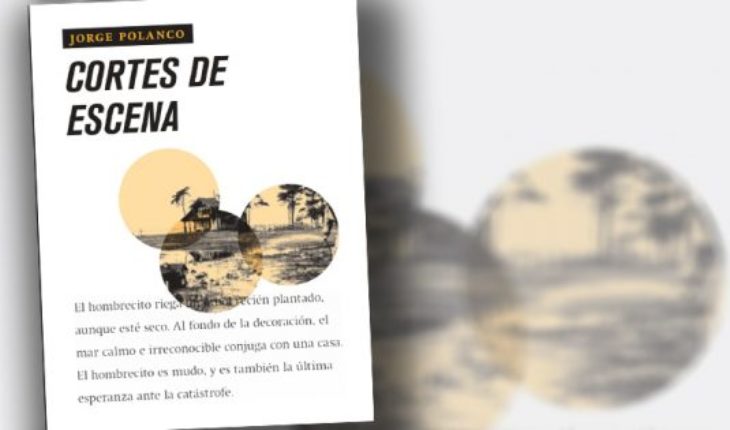“Innocence is the child, and I forget, a new beginning,
a game, a wheel that moves on its own,
a first move, a saint say if”
Friedrich Nietzsche.
The heading that underpins this writing serves to illustrate several aspects of the poetry that Jorge Polanco gives us in “Scene Cuts”, his last book of poems highlighting childhood, memory, play, autopoiesis, movement and the will to live thrown into the future with prevailing themes. A book that, while true, is written in poetic prose, can also be said to blur genres, thus passing through poetry, music, ethnography, film script, philosophy, essay and even references to painting and photography.
As for the topics addressed in this book, it is interesting to treat memory when the author approaches statements from third parties when he says that: “Alejandra (…) once told me that memory repeats itself in her as elbows in the dark, and that maybe one day without realizing it we will die of so much past” (p.9) or an untimely vision of a political look of reparation, putting a will for the future before it, an absolutely endearing vision: “Today, on London Street (…) No one advances in this city, only friends who continue their march among the lanterns, ignoring number 38” (p.25).
Another important theme that crosses the text is that of friendship, philosophy and readings through, images and ideas that also convey how people’s lives fork the passage of time and the always unpredictable avatars of life: “We read Nietzsche, Baudelaire and Sartre with the impression of a year-over-increased nausea. (…) Today Fernando has two children, is married and the darkness of the piece increases over the years” (p.11), likewise, this image of friendship and philosophy are united in other parts of the text: “My friend deleuzeano often speaks of rhizome and wanting machines (…) philosophy is only that, he tells me, another way of being afraid” (p.12), u: “Francisco Pimentel died today. He was an expert in Judeo-German philosophy and his henchmen (…) what I remember most from his conversations is a codephrase he said to me at the end: the ways of speaking always give the executioner away” (p.14).
But one of the great themes of this book is that of childhood approached in various ways, for example, in the voice of a boy who does not hide his misdeeds, which transforms him into an endearing character that we could label as a kind of antihero : “The neighbor’s house had been left unoccupied (…) the phone boxes looked useful and we thought we’d get a device (…) we made calls to relatives, known in remote regions (…) we started charging for the use of the phone (…) We had raised enough money to spend on Samoa video games (…) It was a clever way to whiten the silver and deny the rumors at all costs. We passed some chips to neighbors our age and the younger ones we threatened to hit them if they ratted us out.” (p.19), or as a being who suffered traumatic episodes, quite far from what Wasillier enacted with his larism – which speaks of a lost paradise – which expands the symbolic possibilities of the poem with other senses: “It was the shortcut to school (…) suddenly a pack approached (…) I saw pieces of my legs being pulled out. There were a lot of rabid dogs.” (p.26). We also see how spaces are opened to the urban mythologies of childhood, as in the poem “When children said the organ grinder brought death” that says somewhere that: “The fault must be the boxes that the parrot opens guessing the terrible things that are going to happen” (p.34), or the sports memoirs of childhood: “The Bahamondes truck was the centerof the team. Our club played second and the kids looked at the level of a movie star, even though all they knew how to do was bust the ball” (p.35). Daily world, with its pleasures, passions and horrors.
The other relevant themes of the book and in which most of the texts and their contents converge is cinema in its technical dimensions, when it mentions instruments of vision: the telescope, “Located a thousand meters from the building, our neighbor looks through a telescope at the scene of a marriage” (p.49); the camera, “Photographs this morning the gloomy nooks and crannies of Valparaiso. You open the door and Carolina is sitting with her legs on top of the chair. Photography is a mirror of ghosts” (p.50); microscope, “You went from page to page following the increasingly attentive annotations, like a microscope that increases the minuscule” (p.79), next to locations such as bars, houses, rooms, beaches, stairs, streets and others that complement the actual cinematic of this book, which pans idyllic scenes, such as when it tells us that: “In the background appeared the image of a ship that crossed misty as the beginning of “Death in Venice” of Luchino Visconti and we began to talk about the beauty of the reddish colors mixed with the blurred motion of the clouds, as if we were privileged spectators within a painting” (p.16) or reference documentaries that build the political memory of the country as in the poem “The Battle of Chile“, or universal cinematography as in poems “Tarkovsky’s interstellar regions“, “Herzog” or “The Turin Horse“. In short, “Innocence is the child, and I forget, a new beginning, a game, a wheel that moves by itself, a first movement, a saint say if“, with an omniscient image of women as an embodiment of emotions and feelings.
A book with many layers of meaning that can perfectly be read in keys similar to a mobile puzzle, such as a film of experimental high felling, of great appeal and mystery.
Stage Courts, Jorge Polanco, Isofónica Editorial, February 2019, 81 pages.
Ramiro Villarroel Cifuentes. Writer.
The content poured into this opinion column is the sole responsibility of its author, and does not necessarily reflect the editorial line or position of El Mostrador.





